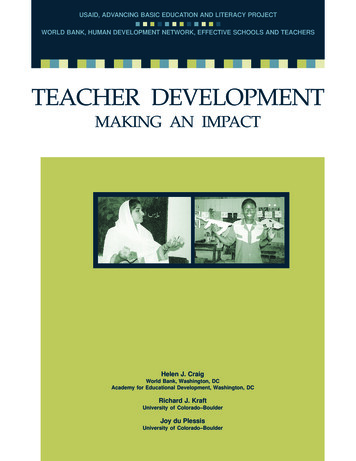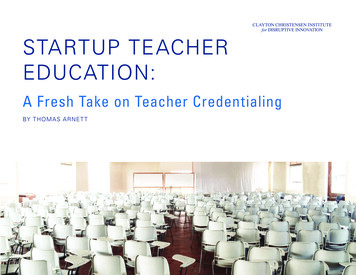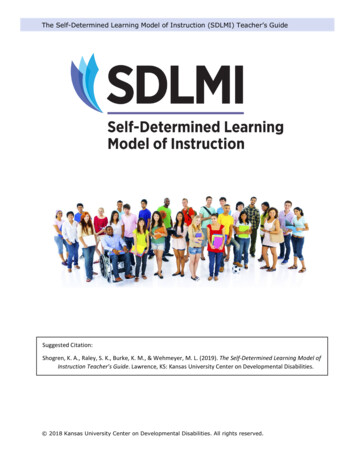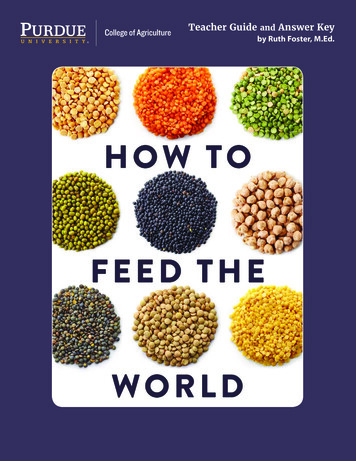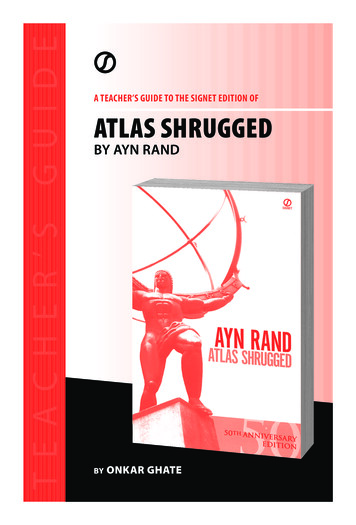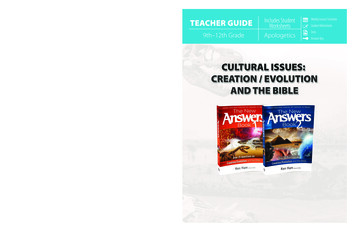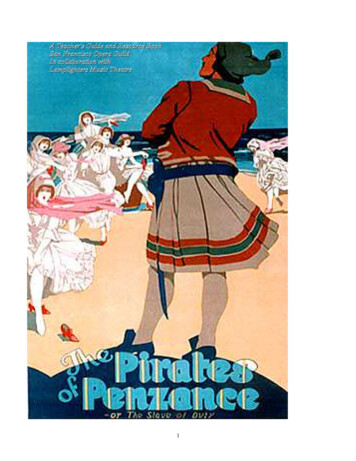
Transcription
A Teacher's Guide and Resource BookSan Francisco Opera GuildIn collaboration withLamplighters Music Theatre1
Cover Art: Poster from The Pirates of PenzanceBritish production, Anonymous1930s2
The mission of San Francisco Opera Guild is to provide cultural nourishment to theNorthern California community through education, outreach programs and specialevents and financial support to San Francisco Opera Association.3
TABLE OF CONTENTSIntroductionThe Cast and the StoryArthur Sullivan: ComposerWilliam S. Gilbert: LibrettistRichard D’Oyly Carte: ProducerA Little History and A Map of CornwallThe World of Gilbert and Sullivan:Elements of Comedy/Parody, Satire and TopsyturvydomThe Constabulary: “Undaunted Men in Blue”Brief History of OperaOperatic VoicesCareers in OperaSan Francisco Opera GuildLamplighters Music TheatreA Brief History of San Francisco OperaCurricular ConnectionsRehearsal PreparationDrama: Readers’ Theatre PantoMovement: Staging Games/ Director SaysMore Warm-up GamesMusic and Language:Standard British DialectI Am the Very Model of a Modern Major GeneralThe Pirates of Penzance GlossaryTalk Like a Pirate DayVisual Art: StoryboardingProduction/ Crafts: Frederic’s Birthday PartyRehearsal EvaluationKids’ Assessment PagesExtensionsLanguage Arts:Language, Writing and Nonsense WordsWriting: Everyone’s a CriticScience and MathThe Leap Year: Calendars and TimeSuggestions for Further InvestigationFun! Coloring PagesMabelPirate with SpyglassPirate with BlunderbussTreasure IslandAppendices:General Opera GlossaryBibliographyDiscographyRelated FilmsRelated WebsitesEvaluation Forms4page 5page 6page 8page 9page 11page 272829page 31page 33page 35pagepagepagepagepagepage363839404244page 46 - 47page 49 - 52page gepagepagepagepage626464646566
Dear Educator:Welcome to The Pirates of Penzance! We are thrilled that you are participating in San Francisco OperaGuild's 2005 education programs. The Opera Guild's Teacher's Guide for Gilbert and Sullivan’sThe Pirates of Penzance is a publication that you can use as a tool to assist you in preparing your studentsfor their exposure to opera in general and to the 2005 Opera à la Carte production of The Pirates ofPenzance in particular.The Teacher's Guide is designed for you to easily incorporate topics or subjects that will be useful to youand your students. The Table of Contents in the front clearly illustrates where to locate information onareas you wish to cover with your students. Among the areas that may help you to prepare your studentsare: Study Guide for The Pirates of Penzance - including background information on the opera, its origin,plot synopsis, biographical information on the composer, and useful historical information.Information in this section that is linked to instructional activities is designated with the CurricularConnections mascot, The Major General: Opera Study Section - including a section on instruments of the orchestra, voice parts, Careers inOpera and an opera glossary.Lesson Plans and Activities Section - including lesson plans and topics for discussion.Appendices – including bibliography, discography, related reading list, a list of related films and a listof related Websites. Corresponding State Standards are listed on each suggested lesson.As always, we welcome your comments and suggestions. Your feedback is invaluable to us in ensuring thatour programs are both enjoyable and relevant to your curricula. We hope that you will let us know aboutany additional activities that you have initiated with your students which you think might enhance futureTeacher’s Guides. Please take a moment to complete the evaluation form at the back of this Guideand return it to our offices; we DO read these! Once again, thank you for your interest and participationin our programs.and enjoy the Opera!Stephanie LoseeCarol WeinsteinVice President, EducationEducation Director, Contributing EditorSan Francisco Opera GuildSan Francisco *****************************************The Pirates of Penzance Teacher's Guide 2005 San Francisco Opera Guild.Acknowledgments: Brooke Farrand; Bonita Hagbom; Ellen Kerrigan;Lamplighters Music Theatre: http://www.lamplighters.org;San Diego Opera Education and Elizabeth Otten;www.TalkLikeAPirate.com and Mark “Cap’n Slappy” SummersSan Francisco Opera GuildWar Memorial Opera House, 301 Van Ness AvenueSan Francisco, CA 94102415.565.3238/ email: education@sfopera.com / Be sure to visit our website at: http://www.sfopera.com/5
The Pirates of PenzanceCASTMAJOR-GENERAL STANLEYbaritoneTHE PIRATE KINGbaritoneSAMUEL, a piratebaritoneHORATIO, a pirate(created for Opera à la Carte version)baritoneFREDERIC, the Pirate ApprenticetenorSERGEANT OF POLICEbassMABEL, daughter of Major-General StanleysopranoEDITH, daughter of Major-General StanleysopranoKATE, daughter of Major-General Stanleymezzo-sopranoISABEL, daughter of Major-General StanleyRUTH, a Pirate maid-of-all-worksopranocontraltoChorus of Pirates, Police, and General Stanley’s wardsACT I – A Rocky Seashore on the Coast of CornwallACT II – A Ruined Chapel by MoonlightSetting: The shores of Penzance, Cornwall, in the, mid- 19th century.6
The Story . . .When Frederic was eight years old, Ruth, his nurse, was told to apprentice him to be a pilot(An apprentice is a young person who learns a trade by living and working with a professionalfor several years.) Being hard of hearing, she misunderstood the instructions and apprenticedhim to the Pirate King. Now that he has finally reached the age of twenty-one, and havingdutifully served his piratical apprenticeship (with Ruth at his side as a kind of maid-of-all-work)Frederic is preparing to leave the pirate band. With but half an hour left to serve, Fredericwarns the Pirate King that from now on, he will have no other choice than to devote himself totheir extermination. He urges the pirates to join him and leave behind their life of crime. Theyrefuse and leave.Ruth begs Frederic to marry her and take her with him. Since he has seen no other womenbesides Ruth in his thirteen years at sea, he does not quite know whether to believe her when she saysthat she is beautiful. Also, he is not too sure how he feels about taking a forty-seven year-old wife.Just then, a group of girls, all the daughters of Major General Stanley, appear on the beach. At onceFrederic sees their beauty – contrasted with Ruth’s plain looks – and he rejects her. One of these girls,Mabel, takes a particular interest in Frederic, and he in her. As he woos her, the pirates return andseize the girls, determined to marry them on the spot. Fortunately, the Major General arrives andconvinces the pirates not to follow their plan. He tells them that he is an orphan, and the pirates feelso sorry for him that they let him and the girls go free.The Major General is not really an orphan, and he feels guilty for lying. He has taken to spendingsleepless nights sitting and thinking in a ruin on the grounds of his newly purchased castle. He ischeered up by his daughters’ sympathy and Frederic’s plan to lead a band of police against the pirates.The police arrive and are enthusiastically sent off by the Major General and his daughters, leavingFrederic alone.The Pirate King and Ruth show up and confront Frederic with some news of their own.They have discovered that his apprenticeship was to run until his twenty-first birthday. Unfortunately,Frederic was born on February 29th, and he has really had only five birthdays. He has a strong senseof duty, so Frederic immediately rejoins the pirates. He also feels that he must always tell the truth, sohe tells them that the Major General is no orphan. Awaiting the perfect opportunity, the pirates sneakup on the Major General and capture him. In the nick of time, the police come to the rescue andcharge the pirates to yield “in Queen Victoria’s name.” This they do. Ruth explains that these menwho appear to be lawless pirates are really all “noblemen who have gone wrong.” The Major Generalpardons the pirates, and they are permitted to marry his daughters.7
Arthur Sullivan: Composer for The Pirates of PenzanceSir Arthur Seymour Sullivan (May 13, 1842–November 22, 1900) was a British composer bestknown for his operatic collaborations with librettist William S. Gilbert. Sullivan was born in Lambeth,now part of London. His father was a military bandmaster, and by the time Arthur had reached the ageof 8, he was proficient with all the instruments in the band. Following a stay at private school inBayswater, he was admitted to the choir of the Chapel Royal, attending its school in Cheyne Walk.While there, he began to compose anthems and songs. In 1856, he received the first Mendelssohn prizeand became a student at the Royal Academy of Music until 1858.In 1858, Sullivan travelled to Leipzig, where he continued his studies and took up conducting.He credited this period with tremendous musical growth, and his return to London in 1862 saw theproduction of his incidental music to Shakespeare's The Tempest performed at the Crystal Palace. Hebegan building a reputation as Britain's premier composer, and 1866 saw the first performance of hisSymphony in E Major (Irish). Other pieces from this period include the overture In Memoriam (1866),the oratorio The Prodigal Son (1869), the well-known tune to the hymn Onward Christian Soldiers(1872, lyrics by Sabine Baring-Gould) and the song The Lost Chord (1877, lyrics by Adelaide AnnProcter). In 1866, he supplemented his income by producing the musical score to a one act operetta,Cox and Box. This led to his most famous and lucrative works as a composer for the musical theatre.In the autumn of 1867, he travelled with Sir George Grove to Vienna, returning with a treasure-troveof undiscovered Schubert scores.In 1871, John Hollingshead commissioned Sullivan to work with Gilbert to create the burlesqueThespis for the Gaiety Theatre. The show was successful in the context that it was conceivedspecifically as a Christmas entertainment and as such ran through to Easter 1872. Plans to revise andrevive the piece in 1876 were abandoned when Richard D'Oyly Carte's backers demanded a new showfor their money and not a revival. The score was subsequently lost, though one number Little Maid ofArcadee was published by Cramer in 1872 and another was later re-used in The Pirates of Penzance.Recent research would seem to indicate that more than just this one number was reused in the latershow.Gilbert and Sullivan's real collaborative efforts began in 1875 when Richard D'Oyly Cartecommissioned them to write a one act piece, Trial by Jury. Its success was so great that the three menformed an often turbulent partnership which lasted for twenty years and thirteen operettas. Trial wasfollowed in 1877 by The Sorcerer, and in 1878 by their greatest success so far, HMS Pinafore. Thislast was much pirated in America, and in 1879, Gilbert and Sullivan crossed the Atlantic to protecttheir copyrights, producing The Pirates of Penzance in New York.The next Gilbert and Sullivan operetta, Patience, opened at the Opéra Comique in London in1881 and was transferred to the specially-built Savoy Theatre later the same year. All the duo'ssubsequent collaborations, which include Iolanthe (1882), The Mikado (1885) and The Yeomen of theGuard (1888), opened there, and the genre of operetta that they created is sometimes known as "Savoyopera" as a result. In 1883, Sullivan was knighted by Queen Victoria. Contemporary critics felt thatthis should put an end to his career as an operetta composer, believing that a musical knight should notstoop below the level of oratorio or "grand opera". Sullivan too, despite the financial security theSavoy operettas gave him, increasingly viewed his work with Gilbert as unimportant and beneath hisskills. Furthermore he was unhappy that he was having to tone down his music to ensure that Gilbert'swords could be heard. In 1886, Sullivan went some way to appeasing his critics by the production ofthe cantata The Golden Legend, which he and most of his contemporaries considered his masterpiece.Gilbert wrote the more serious Yeomen to satisfy Sullivan's urge for grand opera, and while Sullivanwas pacified for a time, in 1890 he broke away acrimoniously from Gilbert following the production ofThe Gondoliers and, with D'Oyly Carte, produced his only grand opera, Ivanhoe, at the new EnglishOpera House. Subsequently however, he returned to work with Gilbert on two more operettas andwrote three more with other collaborators.Sullivan, who had suffered from ill health throughout his life, succumbed to pneumonia at hishouse in London on November 22, 1900. A monument in his memory was erected in the VictoriaEmbankment Gardens.8
William S. Gilbert: Librettist for The Pirates of PenzanceSir William Schwenck Gilbert (November 18, 1836 – May 29, 1911) was a British dramatistand librettist best known for his operatic collaborations with the composer Arthur Sullivan. Gilbertpublished numerous short pieces of humour and was a cartoonist.Gilbert's father, also named William, was a naval surgeon and he spent much of his youthtouring Europe before settling down in London in 1849, later becoming a novelist in his own right, themost famous of his works being The Magic Mirror, the original edition of which was illustrated by hisson. Gilbert's parents were distant and stern, and he did not have a particularly good relationship witheither of them. Following the breakup of their marriage in 1876, his relationships became even morestrained, especially with his mother. In the late 1850s and early 1860s, he began a career as a barrister,supplementing his income and indulging his creative side with the publication of many short illustratedpoems in the magazine, Fun, using the childhood nickname "Bab" as his pen name. As a result thepoems have become known as the Bab Ballads. The ballads proved to be very popular and were laterpublished in book form several times. In addition, Gilbert used some of them as the base concepts forseveral of his librettos, including Trial by Jury and Pinafore.In 1863, he wrote his first professional play, Uncle Baby, which ran for seven weeks. Thisrepresented his only dramatic success until 1866 when he had a burlesque and a pantomime produced.The following year, he married Lucy Agnes Turner. Following their marriage, he began to turn hisattention more and more to writing for the stage and directing his work so that it would resemble hisvision. Gilbert became a stickler that his actors interpret his work only in the manner he desired. Thisran against the production style of the times, which was to let the actors have their way, the result ofwhich had been a decline in the quality of English playwriting and dramatic production over the courseof the late 18th century and the first half of the 19th century. By helping to reverse this trend, Gilbertnot only improved the production of his own work; he also created an environment in which the workof later and more highly regarded playwrights such as Oscar Wilde and George Bernard Shaw could beproduced properly. It is more important that these authors' plays are produced in the manner that theirauthors intended, and thus it could be argued that Gilbert indirectly encouraged the creation of theirwork.In 1871, John Hollingshead commissioned Gilbert to work with Sullivan to create theGrotesque Operetta Thespis, or The Gods Grown Old for the Christmas season at the Gaiety Theatre.This proved successful in that it outran five of its nine competitors, closingonly at Easter and being revived for the benefit of Nellie Farren, one ofits stars, later in April 1872. However, this proved to be a false start inthe men's collaborative efforts. It would be another four years before themen worked together again. Gilbert and Sullivan's real collaborativeefforts began in 1875 when Richard D'Oyly Carte commissioned them towrite a one-act play, Trial by Jury. The operetta's success was so greatthat the three men formed an often turbulent partnership which lasted fortwenty years and a further twelve operettas. Initially D'Oyly Carte'scompany, known as the Comedy Opera Company, needed to enlistThe first work to be presented by the new company at London's OperaComique was The Sorcerer in November 1877. This was followed byH.M.S. Pinafore in May 1878, which, despite a slow start, mainly due toa scorching summer, became a red-hot favourite in the autumn, causingthe directors to storm the theatre one night in an attempt to steal the setsC a r i c a t u r e f r o m P u n ch , 1 8 8 1and costumes to mount a rival production. The attempt was repelled andD'Oyly Carte continued as sole impresario of the newly renamed D'Oyly Carte Opera Company.9
While working with Sullivan on the Savoy Operas, Gilbert continued to write plays to beperformed elsewhere, both serious dramas (e.g. The Ne'er-Do-Weel, 1878) and more humorous works(e.g. Foggerty's Fairy, 1881).Sullivan, too, had a career of his own. Two ballets, a symphony, a cello concerto, and anumber of large-scale choral pieces, incidental music to five of Shakespeare's plays and, of course,other operatic works, including Ivanhoe, which opened D'Oyly Carte's new Royal English OperaHouse (now the Palace Theatre) in Cambridge Circus in 1891.Gilbert and Sullivan had many rifts in their career, partly caused by the fact that each saw himselfallowing his work to be subjugated to the other's, and partly caused by the gap in their social status.Sullivan was knighted in 1883, not long after the company moved to its new home, the Savoy Theatre.One suspects however that this knighthood was not so much for his work with Gilbert, but more for hismore 'serious' music such as the musical drama The Martyr of Antioch, first produced late in 1881;Gilbert's family was lower in the social order and he was not recognized until 1907, when he wasknighted by King Edward VII. In any event, Gilbert filled his plays with a strange mixture of cynicismabout the world and "topsy-turvydom" in which the social order was turned upside down. The latter inparticular, did not go down well with Sullivan's desire for realism (not to mention his vested interest inthe status quo).In 1893, Gilbert was named a Justice of the Peace in Harrow Weald. Although he announced aretirement from the theatre after the poor initial run of his last work with Sullivan, The Grand Duke(1896), he continued to produce plays up until the year of his death including an opera, Fallen Fairies,with Edward German (Savoy 1909), and an excellent one-act play set in a condemned cell, TheHooligan (Colliseum 1911). Gilbert also continued to personally supervise the various revivals of hisworks by the D'Oyly Carte Opera Company.On 29 May 1911, he was giving swimming lessons to two young ladies at his lake when one of thembegan to flail around. Gilbert dived in to save her, but suffered a heart attack in the middle of the lakeand drowned.G ilb er t & S ull iva n ,b y A lb er t Br yan 187 510
Richard D’ Oyly Carte: ProducerRichard D'Oyly Carte (May 3, 1844 – April 3, 1901)was a London theatrical impresario during the latterhalf of the nineteenth century. Although an amateurD'Oyly Carte was born in Soho's Greek Street inthe West End of London. His father was aninstrument salesman and D'Oyly Carte was raisedwith a musical background. He attended theUniversity School of London, but left before graduation in order totake a larger role in his father's business. Between 1868 and 1877, hewrote the music for three comic operas, Doctor Ambrosias—HisSecret, Marie and Happy Hampstead. At the same time, he wasbeginning to build an operatic and concert management company.In 1875, he became the business manager of the RoyaltyTheatre. The first show he booked was Jacques Offenbach'sLa Périchole. Because the opera was short, he commissioned WilliamS. Gilbert and Arthur S. Sullivan to write a one-act operetta to fill outthe evening, which became Trial by Jury. Building on its success,D'Oyly Carte entered a partnership with Gilbert and Sullivan andformed the Comedy Opera Company to produce their future works,along with the works of other British lyricist/composer teams. The first operetta produced was TheSorcerer in 1877.By the fourth full-length collaboration between Gilbert and Sullivan, D'Oyly Carte was able tobuild his own theatre, the Savoy. On October 10, 1881, the new theatre opened with the showPatience. At the time, the Savoy seated nearly 1300 people and was the first public building to be litentirely with electric lights. Prior to the first performance, D'Oyly Carte stepped on stage and broke alit lightbulb to demonstrate the safety of the new technology.Gilbert and Sullivan had a tumultuous relationship, and D'Oyly Carte was frequently able tosoothe their animosity by a mixture of friendship and business wrangling. In the late 1880s, as theproblems grew and Sullivan and Gilbert became more adamant in their refusals to work together,D'Oyly Carte built the Royal English Opera House in Cambridge Circus close to Covent Garden tohost what he hoped would be a birth of British opera. The first production was of Sullivan's only grandopera, Ivanhoe. When it closed, there was nothing to replace it and the venture failed, the new OperaHouse becoming the Palace music hall.D'Oyly Carte was married twice. His first wife was Blanche Prowse, the daughter of a pianomanufacturer. They had two sons, Lucas and Rupert. In 1888, D'Oyly Carte married Helen Lenoir(a.k.a. Helen Cowper-Black) who had worked as his assistant from the 1870s and continued to workwith him until his death, after which she took over the running of the company.D'Oyly Carte died on April 3, 1901, leaving behind the D'Oyly Carte Opera Company, the SavoyTheatre and the Savoy Hotel. He is buried in the churchyard of St. Andrews Church in Fairlight.Preceeding biographical information on Arthur Sullivan, William S. Gilbert and Richard D’ Oyly Carte is used bypermission of Wikipedia, The Free EncyclopediaCopyright (C) 2000,2001,2002 Free Software Foundation, Inc.59 Temple Place, Suite 330, Boston, MA 02111-1307 USAEveryone is permitted to copy and distribute verbatim copies of this license document,but changing it is not allowed.11
A Little HistoryPenzance is a resort in Cornwall, Great Britain, and it is a port for the Scilly Islands.(Yes, that IS their name. The main port in Penzance is called Mousehole. Really.)It also has flour mills.Since it has been known as a sleepy resort town since the late 1700s, the Victorianaudience probably would have started laughing just on hearing the title of this show.However, the town was vulnerable to piracy. It was sacked and burned by the Spanish inthe late 1500s and had to be almost entirely rebuilt. Until the 1700s it was subject toraids by Mediterranean pirates.Gilbert and Sullivan's operetta, The Pirates of Penzance, depicts the raids, and satirizestheir own (Victorian) society.And A Map of Cornwall12
The World of Gilbert and Sullivan(Elements of Comedy Writing)The world of Gilbert and Sullivan is one of extreme comedy, and there are a few classic comedicelements that are standard to all of their work:ParodyThe Merriam-Webster Dictionary defines parody as: a composition that imitates another workhumorously or satirically.Parodies make fun of the form of other work, but copying that form and exaggerating it tomake it look ridiculous. A standard example is the Happy Birthday Song:Standard lyrics:Happy BirthdayHappy BirthdayHappy BirthdayHappy Birthdayto you,to you,dear William,to you!The parody of this song is often:Happy Birthday to you,Happy Birthday to you,You smell like a monkey,You look like one too!W.S. Gilbert created comedy using some very specific structures, and making fun of standardforms of Victorian entertainment was part of the way he made his audience laugh. This is rathersimilar to the way we may laugh at The Daily Show, because it makes fun of the forms of standard‘serious’ news shows on television. In the San Francisco Bay Area, some of the best live performanceparody is created and performed by Beach Blanket Babylon, which parodies popular celebrities andother people in popular culture. Most of Gilbert’s parody focuses on the musical standards of the day;Mabel’s song “Poor Wand’ring One” is a direct musical parody of the opera style made famous bycomposer Gaetano Donizetti.Most parody is really funny when it uses the form of other people’s work to make us laugh; bydefinition, parody mocks, or criticizes the work of others. Not everyone takes this very well. Forinstance, in 1964, Roy Orbison wrote a classic American pop tune called “Pretty Woman.” In theearly 1990’s the hip hop/rap group 2 Live Crew reworked it into “Big Hairy Woman [You Need toShave That Stuff]”, and Orbison’s publisher sued 2 Live Crew for copyright infringement. The UnitedStates Supreme Court heard the case, and decided in 2 Live Crew’s favor, and against the publisher.(Pretty Woman vs Hairy Woman 1994)As Peter Strand states in The Parody Archive, “ The parody exception allows use of another’swork, but only to the extent necessary to call to mind the original work, because parody is a means ofpromoting discussion and criticism, central to the effectiveness of the First Amendment. The parodyfair use defense was most recently upheld by the United States Supreme Court in 1994 when it ruledthat 2 Live Crew’s reworking of the Roy Orbison song “[Oh] Pretty Woman,” as “Big Hairy Woman[You Need to Shave That Stuff]” was parody and therefore permissible fair use despite the objection ofthe music publisher of “[Oh] Pretty Woman.”1Gilbert apparently had better luck with his audience, because he was never sued for copyrightinfringement or libel due to the form or content of his shows. However, he was in court more thanonce defending himself against accusations of character defamation; he was fond of humiliating hisactors, and had a reputation for ruthless and often brutal behavior.SatireThe Merriam-Webster Dictionary defines satire as: biting wit, irony or sarcasm used toexpose vice or folly; a literary work having these qualities.Gilbert used all of the elements listed in this definition to create his comedy, and no one inBritish society was spared. In The Pirates of Penzance, Gilbert mocks classism (any form of prejudiceor oppression against people who are in, or who are perceived as being like those who are in a lowersocial class.)2 The Major-General has just purchased a new castle, and has purchased ‘ancestors’ along1The Wind Done Gone: Parody or Piracy; 2001/Peter Strand; www.mbc.com;2From Wikipedia, the free encyclopedia; http://en.wikipedia.org/wiki/Classism13
with the rest of the property. This was actually a common practice amoung the upper classes, whowere determined to prove the purity of their lineage, and therefore their right to their place in upperclass society. Even the pirates are part of the class-privilege system; the pirates are pardoned for theircrimes because the are “all noblemen who have gone wrong.” Gilbert also satirizes the military; theMajor-General is portrayed as an over-educated, under-experienced Peer of the Realm, with lots ofbook smarts and no battle experience. At the time that Gilbert wrote the piece, officer training was astandard route for many young men of the upper classes and nobility, and they routinely ‘bought’ theirway into the officers ranks, without earning rank through training. The privileged officers’ lack ofexperience in actual combat was a sore point for many of the (low- and working class-) enlisted men.Of course, the other sector of society that Gilbert satirizes in Pirates, are the police, who :SERGEANT:POLICE:Though in body and in mindTarantara! tarantara!We are timidly inclined,Tarantara!And anything but blindTarantara! tarantara!To the danger that's behind,Tarantara!Yet, when the danger's near,Tarantara! tarantara!We manage to appearTarantara!As insensible to fearAs anybody here,As anybody here.Tarantara! tarantara!The first police force had been created in London in 1829, and the citizenry did not support theminitially. By the time Pirates hit the stage, however, the police had become an accepted and often evenadmired part of London (and British) civil society. This acceptance made it all the more comfortablefor the Victorian audience to laugh at the goofy policemen they saw onstage in Pirates.Topsy TurvydomTopsyturvydom is the world turned on its head – a structure that takes satirical exaggeration,and pushes it to the next, ridiculous level.Gilbert made liberal and consistent use of Topsyturvydom, but the concept and the use of itactually is an old form for comedy writing, and shows up in the master/servant confusions and rolereversals in Greek and Roman comedies, as well as in Shakespeare’s world (most notably in hisTwelfth Night, or What You Will). In the Topsy Turvy world, all values are reversed from what weassume to be the social norm. Gilbert wrote these notes for his play, Topsyturvydom, which opened in1874(six years prior to the opening of Pirates):“Children are born learned, gradually forget everything until, as old men, they are utterlyignorant . . . Vice is rewarded. Virtue punished . . . Dishonesty is rewarded . . . Cowards arehonoured . . . Therefore the most ignorant, the most vicious, the most lazy man is made ruler.”3Other esidx.htmlCarol Weinstein for San Francisco Opera Guild, 20053From Gilbert and Sullivan, the Creative Conflict, by David Eden. Page 126.14
The Constabulary: “Undaunted Men in Blue”(Used by permission of Lamplighters Music Theatre)By the time The Pirates of Penzance was written
Talk Like a Pirate Day page 40 Visual Art: Storyboarding page 42 Production/ Crafts: Frederic’s Birthday Party page 44 Rehearsal Evaluation Kids’ Assessment Pages page 46 - 47 Extensions Language Arts: Language, Writing and Nonsense Words page 49 -



